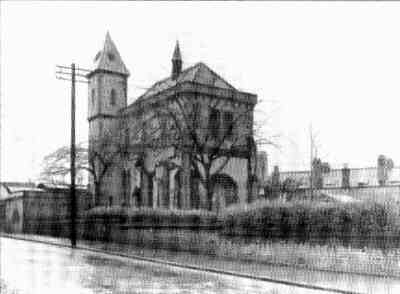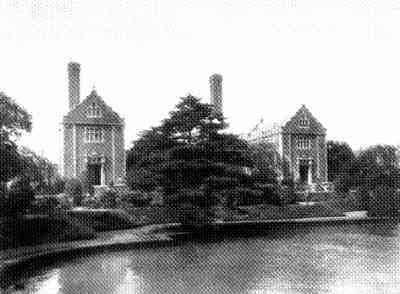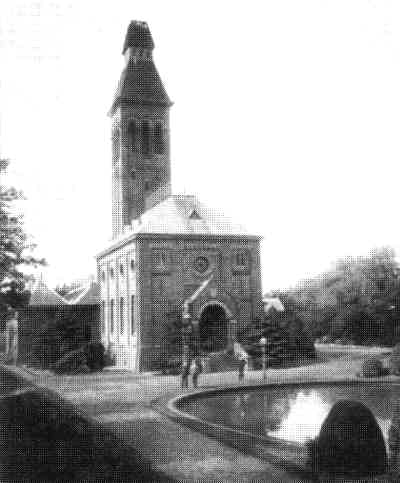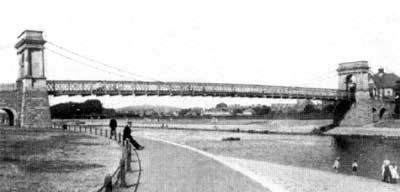|
|
 |
 |
|
 |
|
 |
|
|
|
Extracts from the:-
|
City of Nottingham Water Department
Jubilee of Ownership 1880 ~ 1930
|
Short History of the Waterworks
|
|
Historical Survey 1930
|
|
|
The water supply of Nottingham in the early days was of a very meagre and intermittent character, and the inhabitants were dependent on the Rivers Trent and Leen, or private wells. There were also certain springs in the Town, the water from which was considered to possess curative properties. Water was brought from the rivers in carts and pails, or obtained from public or private wells, which existed in various parts of Nottingham. It is recorded that about 300 wells were available at one time, and that the Corporation, about the year 1800, erected eight public pumps in the following situations:--
one at the West end of Chapel Bar, two were in Parliament Street, one at the top of Charlotte Street, one at Weekday Cross, one in the Shambles, and two in the market place opposite the Exchange and the Beastmarket Hill.
|
|
The original Water Works Company obtained their least from the Corporation in 1696, and erected an engine House, water wheel and pumps on the South Bank of the River Leen at the bottom of Firkin Street, near the site of the present Bowling Green Hotel in a Canal Street. Water was forced through piping 3 1/2 inches diameter from the works in Finkhill Street, via Walnut Tree Lane, into a small open reservoir in the Butte Dyke, on the side of the ancient Postern near the General Hospital.
|
|
The Company was a private one, but the Corporation held six shares out of the 32 into which the undertaking was divided: the shares held by the Corporation appear to have been at sold in May 1717 for the purpose of paying some of the Corporation debts. Peter Whalley is stated to have been the first Engineer. Thomas Hancock, who was appointed Engineer in 1782, died in 1805, and copies of his portrait by Richard Bonington (father of Richard Parkes Bonington) were sold for the benefit of his widow.
|
|
The supply from the River Leen sufficed for many years, but, in consequence of long continued complaints of the quality and scarcity of the water, the Company obtained an Act of Parliament in June 1827 and constructed works at Scotholme, near the present Gas Works at Basford, for the purpose of taking water from certain springs, and tapping the River Leen at a point where it was free from contamination and filth from the Town sewers. The water was collected in a reservoir covering an about one acre, and conveyed by means of 10 inch piping to pumps actuated by means of a water wheel which was driven by water from the River Leen.
|
|
The Company eventually discontinued the use of the old engine near Finkhill Street and erected new premises and plant in the parish of Brewhouse Yard, near the foot of the Castle Rock and on the present site of the Water Offices, and Castle Works Depot. The water was forced from this point by means of a steam engine and water wheel into the old open Reservoir near the General Hospital. The amount of water obtained from the Scotholme the varied from 300,000 to 400,000 gallons per day. Mr. T. Bell, the Engineer, was succeeded by Mr. John Hallam, Mr. James Hewitt being the collector.
|
|
On that the 1st December, 1824, a rival Water Company was formed and established the Northern Waterworks, which were situated at the top Sherwood Street, near Gregory's Place and the Jews' Burial Ground. The Company pumped water (by means of a steam engine made at the Butterley Ironworks) from a well, fed by a deep spring, into a large cistern and which supplied the North Eastern portion of the Town, also a small cistern in York Street, from which the water carriers took their suppliers. The carriers charged at the rate of 1/4d. per bucket, and if water had to be carried any distance up a court the charge was increased to one 1/2d. per bucket. It is interesting to note that a portion of the 4 inch and 5 inch piping laid by this company in Mansfield Road, from the junction with Chatham Street, to York Street, is still in use. Mr. James Sharpe appears to have been at the first Chairman, and Mr. Samuel Jones, Secretary. Mr. James Slark and was the Engineer, and his duties at a later date included the collection of water rents. Apparently he lived rent free in a house belonging to the Company, was allowed coal, and his wages were at the rate of 16s. 0d. Per week. Meetings were held at various public houses in the town, and the members of the Committee were fined 2s. 6d. for non attendance, the fines so levied being appropriated for the purpose of providing an annual dinner.
|
|
Still earlier than the Northern Works were the Waterworks established by Mr. Joshua Beardmore near Sion Hill and Gregory St. (now Holden street). Water was raised by a steam engine from a well 60 yards deep, with a reservoir at the top of the engine house, and then gravitated by pipes to houses in that part of new Radford, to the Barracks, and to the few houses Nottingham Park Side then possessed. These works also supplied the various water-carts that came for the benefit of the poorer inhabitants whose houses are were not connected to the water pipes. Mr. Beardmore eventually sold the well to Messrs. Walker, who had marble works on the Sion Hill, and who needed the water for certain processes in their business.
|
Trent Works
|
|
In May 1826 an Act of Parliament was obtained by the Trent Water Works Company to pump water from the River Trent, but, owing to a bad trade, it was not until 1830 that practical steps were taken to abandon the River Leen as a source of supply, and establish a new works adjoining the River near the Tower Arms Inn at Trent Bridge. The water was not obtained directly from the Trent, but by filtration through brick tunnels in the natural beds of sand and gravel overlying the Bunter Sandstone on the north side of the River, and conveyed into a rectangular storage Reservoir. The water was pumped by means of a single cylinder, rotating beam engine off about 40 H.P. nominal, through a 15 inch main which was laid via London Road, Hollow Stone, the Market Place, St. James's Street, to Park Row Reservoir near the General Hospital. It is interesting to note that this 15 inch main is still in use and in good condition. The main was laid before bitumastic coating as a preservative were thought of, and portions of the original coating of limewash inside the pipes are still visible. The volume of water pumped varied with the height of the River, but it has been generally assumed that the plant was capable of delivering about 600,000 gallons per day.
|
|
The Works, which were completed in 1831, were designed by the late Mr. Thomas Hawksley at the age of 25, and were the first in this Country to inaugurate and maintain the principle of constant high pressure at service. The population of a Nottingham at that time was 50,000, and about 15,000 persons were supplied by the Company. In consequence of the deterioration of the water by the impurities contained in the River Trent, and by other means, the supply from this pumping station was abandoned by the Company on the completion of Bestwood Works. Mr. Hawksley, who was born at Arnold near Nottingham on a 12th July 1807 lived for a time in the house on the Works at Trent Bridge, and remained Engineer to the Company until the supply was taken over by the Corporation; he was also engineers to the Nottingham Gas Company. Mr. Hawksley removed to a London in 1852 and practised as a Civil Engineer in Great George Street, Westminster, until his death, on the 15th September, 1893, at the ripe age of 86 years. His reputation was world-wide, and he will probably rank for all times as the greatest of water engineers. Mr. Hawksley was one of the first to insist upon the use of well-designed water fittings, and the necessity for supervising plumbers' work. He also originated a list of plumbers who were authorized to carry out work in connection with the Nottingham Water Undertaking.
|
|
After existing for some years in the customary rivalry, the Water Companies amalgamated, and in 1845 an Act of Parliament was obtained and the Nottingham Waterworks Company established.
|
Old Water Offices, St. Peter's Gate
|
|
These Offices were built about the year 1872 by the Nottingham Waterworks Company, and used as headquarters until the year 1891, when that the staff was moved to the old General Post Office premises in St. Peter's Church Side. In 1911 the staff was transferred to the present offices in Castle Boulevard.
|
Transfer to Corporation
|
|
The Water Undertaking was acquired by the Corporation under powers contained in the "Nottingham improvement Act, 1879". The Parliamentary transfer from the Company to the Corporation took place on the 25th March, 1880, but there being some little delay in closing the accounts and preparing the necessary legal documents, the virtual transfer was not effected until 14th May, 1880.
|
|
The total area of the Town and surrounding parishes supplied with water at the date of transfer was 41,084 acres or 64 square miles. The total population supplied was 216,992 persons, of which 191,753 were directly supplied with water by the Corporation.
|
|
The five Works which then existed were as follows:-
Scotholme Works, at Basford
Trent Works, near Trent Bridge
Park, or Sion Hill Works, The Ropewalk
Bagthorpe Works, at Basford
Bestwood Works, in Bestwood Park
|
|
In the course of time there suppliers from Scotholme and the River Trent were abandoned by the Water Company on account of pollution.
|
Park or Sion Hill Works
|
|
 These works were established on a site of about half an acre near the junction of the Ropewalk with Derby Road, about the year 1850, and water was obtained from wells about 7 feet diameter, 240 feet deep, connected by driftways, sunk into Bunter beds of the New Red Sandstone. Water was forced through a 12 inch main to Belle Vue Reservoir, or alternatively, through an 8 inch main to Park Row Reservoir. The yield from the wells was estimated to be 850,000 to 900,000 gallons per day. These works were established on a site of about half an acre near the junction of the Ropewalk with Derby Road, about the year 1850, and water was obtained from wells about 7 feet diameter, 240 feet deep, connected by driftways, sunk into Bunter beds of the New Red Sandstone. Water was forced through a 12 inch main to Belle Vue Reservoir, or alternatively, through an 8 inch main to Park Row Reservoir. The yield from the wells was estimated to be 850,000 to 900,000 gallons per day.
These Works were eventually abandoned by the Corporation on account of the extreme hardness of the water, and the possibility of contamination from the General Cemetery. The buildings are now leased to The Midland Motor Co. (Nottm.) Ltd
Click here for a current photograph of the building
|
Basford Works
|
|
 The Bagthorpe, or Basford Works, are situated near the junction of Hucknall Road with Haydn Road on a site of about three acres. The Works were established in the year 1857, and extended in 1868. Water is obtained from three wells each about 110 feet deep, connected by driftways, which are sunk in the Bunter beds of the New Red Sandstone. The yield from this source has remained prolific, and at the present time the Works are capable of meeting all requirements. The Bagthorpe, or Basford Works, are situated near the junction of Hucknall Road with Haydn Road on a site of about three acres. The Works were established in the year 1857, and extended in 1868. Water is obtained from three wells each about 110 feet deep, connected by driftways, which are sunk in the Bunter beds of the New Red Sandstone. The yield from this source has remained prolific, and at the present time the Works are capable of meeting all requirements.
( The original buildings do not now exist, but water is still pumped from the site, using submersible pumps at the bottom of the wells. The site is still used by the water authority, now Seven Trent Water, as a storage depot.)
|
Bestwood Works
|
|
 These Works are situated a little beyond the fifth mile-stone from Nottingham on the Mansfield Road, and were commenced about in the year 1871. Bestwood Works were last constructed by the old Water Works Company, and occupy a site of about six acres, leased from His Grace the Duke of St. Albans, in Bestwood Park. Water is obtained from two wells, each about 176 feet deep, connected by driftways which have been extended from time to time, and are sunk in the Bunter beds of the New Red Sandstone. The engines are excellent specimens of the beam type, and force water to Red Hill Reservoir. For some years the wells at Bestwood were over pumped, and little or no relief could be given until additional Works were constructed at Boughton. As a result of Colliery workings under the site, the pumping station has subsided nearly four feet; fortunately the sinking has been gradual, and it was found possible to keep the plant working during the disturbance of the surface levels. These Works are situated a little beyond the fifth mile-stone from Nottingham on the Mansfield Road, and were commenced about in the year 1871. Bestwood Works were last constructed by the old Water Works Company, and occupy a site of about six acres, leased from His Grace the Duke of St. Albans, in Bestwood Park. Water is obtained from two wells, each about 176 feet deep, connected by driftways which have been extended from time to time, and are sunk in the Bunter beds of the New Red Sandstone. The engines are excellent specimens of the beam type, and force water to Red Hill Reservoir. For some years the wells at Bestwood were over pumped, and little or no relief could be given until additional Works were constructed at Boughton. As a result of Colliery workings under the site, the pumping station has subsided nearly four feet; fortunately the sinking has been gradual, and it was found possible to keep the plant working during the disturbance of the surface levels.
( The building still exists, complete on the outside, being a listed building. When electric pumps where fitted into the wells, the old beam engines were scrapped, and now the inside is used as a 'health spar' and restaurant. )
|
Papplewick Works
|
|
These Works are situated about eight miles North of Nottingham, near the North-east boundary of the Parish of Papplewick. The Works were established about the year 1884, and occupy a site of about six acres, leased from the late Andrew Montagu, Esq., the then owner of the estate. Water is obtained from two wells about 200 feet deep, connected by driftways, which are in the Bunter beds of the New Red Sandstone. The engines are of the beam type, and very ornate. Water is forced through 16 inch and 24 inch mains to Ramsdale and Mapperley Reservoirs; alternatively water can be pumped across country to Eastwood, and other parishes in the North-west portion of the Water Area. It is anticipated that colliery workings may cause subsidence at these Works in the near future. ( Fortunately this has not happened )
|
Boughton Works
|
|
These Works were established in the year 1901, and occupy a site of about 12 acres leased from Lord Savile. The Works are situated in the Parish of Boughton an the outskirts of the Dukeries, 22 miles North of Nottingham, and about 2 miles North of Ollerton L.&N.E. Railway Station. Water is pumped from deep wells and boreholes in the Bunter beds of the New Red Sandstone, and forced through 30 inch main to Red Hill Reservoir. The two wells are about 150 feet deep, but some of the borings go down to a depth of 350 feet. Driftways about 6 feet by 6 feet are driven from the bottom of the wells towards the Southern boundary of the Works. It is interesting to note that water was first pumped to Nottingham by means of temporary plant in the year 1900, in order to meet a shortage which then appeared to be imminent. The main pumping plant at these Works consists of two triple expansion engines, which are each capable of delivering water at the rate of three million gallons per day. Usually one engine only is at work, the second being kept as a standby to meet emergency demands. The reserve pumping plant consists of an independent pump for lifting water from two 18 inch boreholes, and a triple expansion engine, which is capable of forcing water into the mains at a rate of two million gallons per day.
|
|
|
( This building still exists, again a listed building, but the inside turned into office space. The machinery was scrapped when the electric pumps were fitted in the wells and these still pumps water into Nottingham. See the end of 'Nottingham Water History' full version for more details)
|
Burton Joyce Works
|
|
These Works are situated in Shaftesbury Avenue, in the Parish of Burton Joyce, about 6 1/4 miles East of Nottingham and occupy a site of about 8 1/4 acres. The first portion of the Works was commenced in 1989, extended in 1908 and again in 1926. The original plant consisted of steam units which pumped the overflow, under the artesian pressure, from one 14 inch and three 18 inch boreholes about 500 feet deep. The latest plant is electrically driven, and consists of pumps which are suspended about 150 feet down three of the boreholes, and three booster pumps which lift, and force the water from an underground tank fed by the borehole pumps, at the rate of three million gallons per day, into the 10 inch and 16 inch mains to Mapperley and Colwick Hill Reservoirs. Electric current is supplied by the Derbyshire and Notts. Electric Power Company.
|
|
Beeston Boosting Station
|
|
In addition to the above Works, the Committee possesses an electrically driven boosting plant for the purpose of pumping water from the district main in Wollaton Road, to the high level parts of Beeston and Bramcote. The Works are situate in Wollaton Road at a point near Broughton Street in the Parish of Beeston, and were erected in 1924. This plant may not be required when the Bramcote High Level Reservoir is completed.
|
Suspension Bridge
|
|
 This bridge, which is situate about half a mile in a Southerly direction from Trent Bridge, was erected primarily for the purpose of carrying water mains across the river into the Parish of West Bridgford. The bridge has a span of 225 feet, with a footway 12 feet wide which is supported by four steel cables. The 14 inch steel water mains and two 12 inch steel gas mains, are attached to the underside of the footway. The bridge was constructed by Messrs. Handyside of Derby, and completed in 1905. This bridge, which is situate about half a mile in a Southerly direction from Trent Bridge, was erected primarily for the purpose of carrying water mains across the river into the Parish of West Bridgford. The bridge has a span of 225 feet, with a footway 12 feet wide which is supported by four steel cables. The 14 inch steel water mains and two 12 inch steel gas mains, are attached to the underside of the footway. The bridge was constructed by Messrs. Handyside of Derby, and completed in 1905.
( This bridge is still in use today )
|
|
|
|
|

